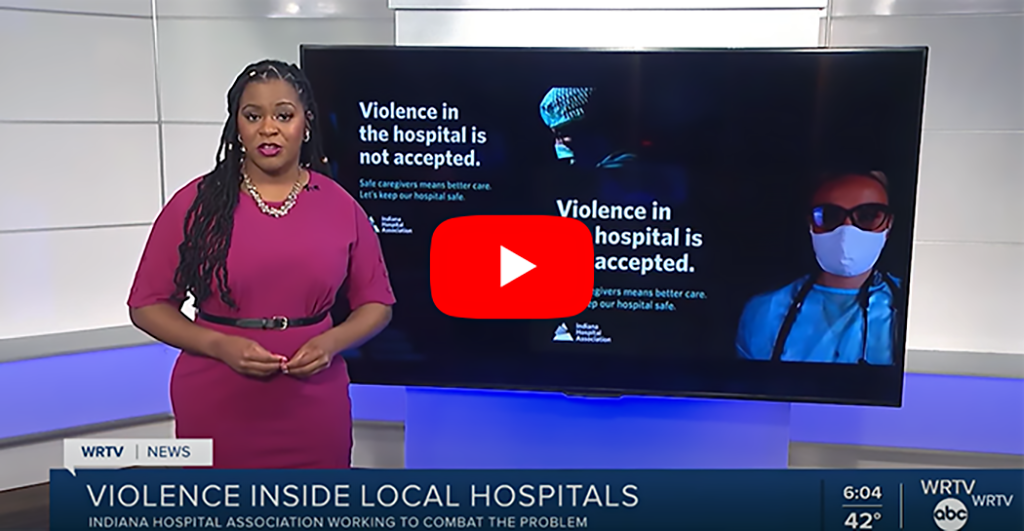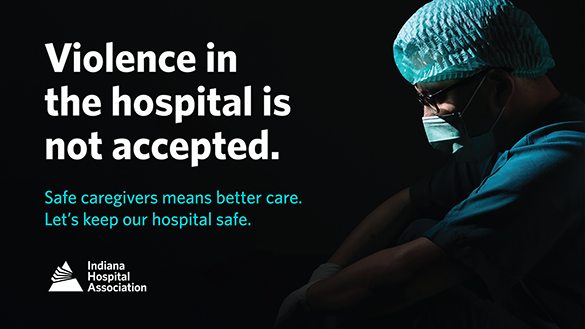
If you turn on the news at any given time, you are bound to see violence happening across the country. If we narrow the scope, violence in health care facilities is increasing at an alarming rate. Across the Hoosier state, there has been an uptick in assaults on nurses, hospital security, emergency room staff, and others within the past few years. While hospitals and health systems have protocols to detect and deter violence, the toll of workplace violence on hospital employees can be immense, ranging from physical and psychological harm to intimidation that prevents hospital staff from providing the best possible care to patients.

To address and reduce violence against our most valuable asset – our health care workers, the Indiana Hospital Association (IHA) has increased efforts and put resources towards a new campaign called the Safe and Sound workplace safety initiative. This comprehensive violence prevention program, which encompasses efforts from all departments within IHA, aims to increase public understanding of the problem of workplace safety and violence while improving data collection and analysis of workplace safety perceptions and events as a means to assess and mitigate risk. The initiative also hopes to gain legislative traction to support health care worker safety, while also providing training to members.
View IHA’s Safe and Sound Toolkit here.
Laurie Gerdt, IHA Quality and Patient Safety Advisor has been behind the efforts of the initiative since the beginning. She says the only way to address violence within the four walls of our hospitals is to face it head-on.

“The public doesn’t see the physical and verbal abuse our health care workers endure on a day-to-day basis,” Gerdt said. “We have to start the conversation that our hospitals do not stand for aggressive behavior.”
So far, IHA has been able increase public understanding of the problem by developing signage for hospital use that reads, “Violence in the hospital is not accepted. Safe caregivers means better care. Let’s keep our hospital safe.” Along with the verbiage and imagery, IHA created easy-to-grab messages, statistics, and visuals to be placed on member social media sites and email signature lines to further push the message of resiliency. IHA also enhanced DataLink reporting to include visualizations of statewide data and national benchmark comparisons.
One Central Indiana hospital has been diving into the issue of workplace safety and joined forces with IHA. Crissy Lough, Risk, Regulatory, and Patient Safety Officer at Eskenazi Health, said violence in their health care facility has increased at a steady rate since the beginning of the pandemic.

“The stress of the pandemic exhausted our staff, and they cannot continue to be assaulted either physically or verbally,” Lough said. “Promoting the reporting of each incident lets our team know they shouldn’t have to endure that to work, and we will continue to stand beside them.”
Indiana hospitals have a no-tolerance environment that is supported by hospital leadership. Most hospitals over the years have adopted best practices such as increased staff training in de-escalation techniques, behavior management skills, and simplified reporting of incidents.
Krystal Hutchinson, Emergency Room Director for Major Health Partners in Shelbyville, has seen an increase in verbal assault in her rural facility.

“Unfortunately, physical and verbal abuse are regular occurrences in the Emergency Department,” Hutchinson said. “Several times a week, we see acts or threats of physical violence, intimidation, and many other disruptive behaviors that affect staff and patient care. Typically, people think physical violence occurs the most, but I feel we have seen a shift to non-physical behaviors such as threats of physical violence, harassment, intimidation, verbal insults, and yelling of profanities.”
While we cannot predict future violent acts, together as an industry, we can remain vigilant, share best practices, increase training, and support our health care workers to make a difference in the outcomes of violent incidents.

“We need a culture change, where things that wouldn’t be acceptable in the outside world shouldn’t be acceptable in the Emergency Department, or anywhere else in a health care organization,” Hutchinson said. “Dealing with violence, threats of violence, and verbal abuse is not part of the job. The more we talk about it, gather data, and realize the magnitude of workplace violence, the more equipped we will be to prevent it. Health care staff should feel safe and supported while caring for others.”

